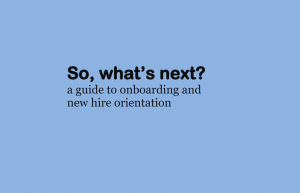Every once in a while I share things here that I’ve put out to our managers. Why? Because I know that many of you struggle with getting your managers on board in some areas, too! The message below is one that I recently passed to our supervisors in order to help them understand the end of the recruiting process.
I see this as a critical juncture, because as the in-house corporate recruiter, I’ve developed a rapport with the candidate and have their trust; however, to ensure that the working relationship goes smoothly, I have to transition them into the care of their supervisor for any future needs. Here’s how I try to set the managers and employees up for success:
Next time you have a new hire coming onboard, please take the time to look at the steps that they will be going through. The HR, security, and accounting teams are working closely with the new hires to make sure they are as ready as possible for their first day of work, but you have a job to do in that regard as well.
You'll notice that there is no specific training to help the new hire fit into your team. Oh, there is an orientation session for new hires, but that is for answering benefits questions, gathering paperwork, etc. The moment they leave the orientation session, they are starting to gather input and learn more about the company and person they will be working for.
Here are a few tips that you can use to help get the employee productive (and profitable) while making them comfortable as well:
1. Email the person a few days before their start date to see if they have any questions, concerns, or comments. Be sure to mention how excited you are about them starting with you.
2. As soon as their orientation session is over with HR, consider implementing your own short orientation session to help get the new hire engaged with regard to team dynamics, communication styles, workload, and anything else they might not think to ask about. (Check with HR if you want some help with developing a department-specific orientation session; we’re happy to help!)
3. Take time often in the first days to ask and answer as many questions as possible. The more time you invest in the person, the sooner you'll be able to “take off the training wheels†and let them do what you hired them for!
More questions? Contact me at HR@….
This isn’t an all-inclusive list, but if I can get managers to understand, accept, and practice these three items, then it will go far in helping them to have a happy, well-adjusted staff from the earliest days of work. If you’re looking for additional ideas, check out the free New Hire Orientation eBook.
What tips and ideas do you share with your managers about onboarding, orientation, etc.?
 The onboarding process can be one of the most overlooked areas for organizations needing a quick win in the overall employee experience. Instead of leveraging this process as a way to drive engagement and create a lasting impression, some organizations tend to deliver a subpar experience or forego the practice altogether.
The onboarding process can be one of the most overlooked areas for organizations needing a quick win in the overall employee experience. Instead of leveraging this process as a way to drive engagement and create a lasting impression, some organizations tend to deliver a subpar experience or forego the practice altogether.
 I ran across this new employee welcome letter example from some old files and had to share. The creator (Antoine) was the best manager out of dozens at a previous employer, and it was little things like this that made his people love him. I had no idea he was providing these documents to his staff for quite a while, but I ran across a copy one day and was astonished at the level of care that he put into being the best leader he could be for his team. (By the way, if you are looking for great ideas to develop or enhance your current onboarding and new hire orientation process, be sure to check out the free
I ran across this new employee welcome letter example from some old files and had to share. The creator (Antoine) was the best manager out of dozens at a previous employer, and it was little things like this that made his people love him. I had no idea he was providing these documents to his staff for quite a while, but I ran across a copy one day and was astonished at the level of care that he put into being the best leader he could be for his team. (By the way, if you are looking for great ideas to develop or enhance your current onboarding and new hire orientation process, be sure to check out the free  Developing your team the “Edward Jones” way
Developing your team the “Edward Jones” way
